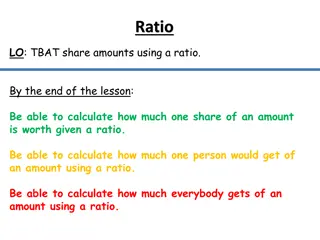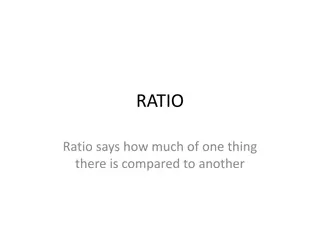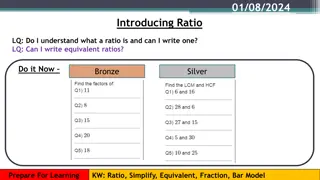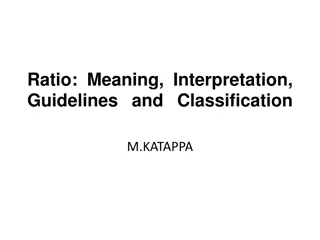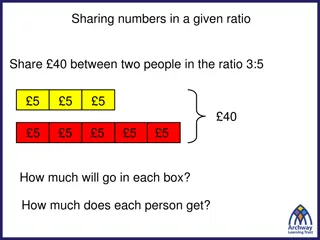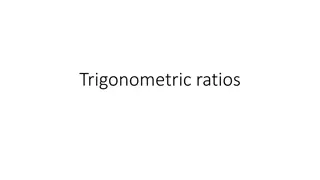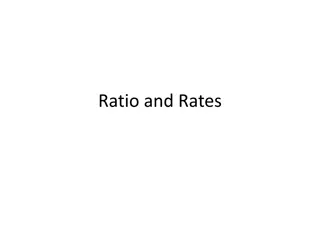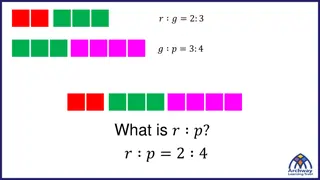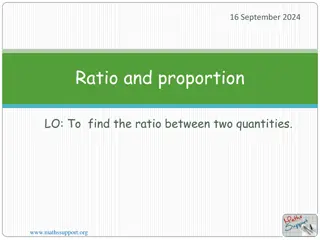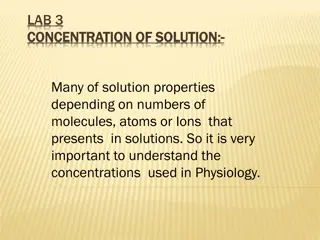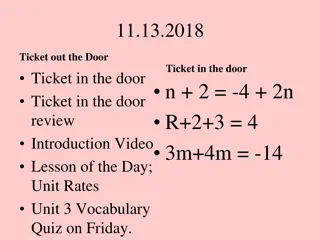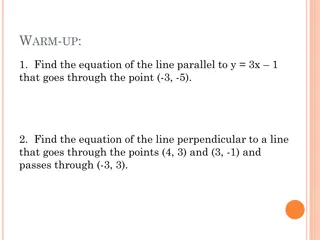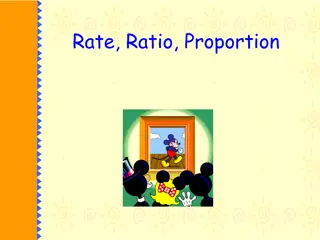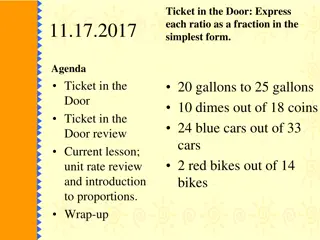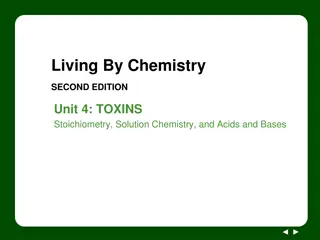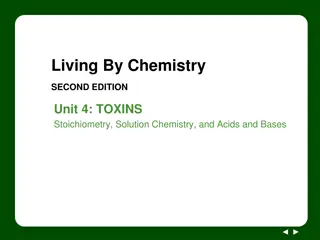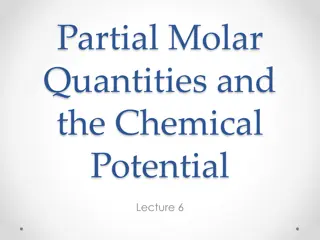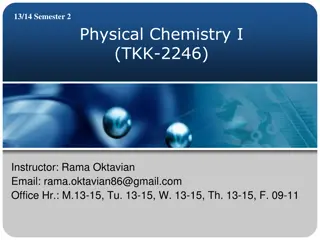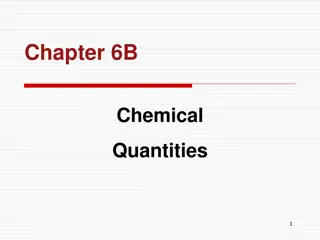Ratio Scenarios Involving Drinks and Bottles
In various scenarios involving students, friends, and families, different ratios of juice, milk, soda water, and other drinks are explored. The content includes voting patterns, combining ratios, making punch, and determining ratios of different beverages used.
2 views • 7 slides
Understanding Chemical Quantities: The Mole and Molar Mass
Explore the concept of chemical quantities through the mole and molar mass. Learn how to measure substances, calculate moles, find molar masses of compounds, and solve related problems in this informative chapter. Discover the significance of Avogadro's number, representative particles, and more in
7 views • 41 slides
Understanding Accounting Ratios and Partner Admission in a Partnership Firm
Accounting ratios play a crucial role in assessing a firm's efficiency and profitability, especially during reconstitution due to partner admission in a partnership. New profit-sharing ratios and sacrificing ratios are key factors that need to be determined in the process. This involves adjusting pr
1 views • 10 slides
Mastering Ratios: Share Amounts and Calculate Values
Explore the concept of ratios through practical examples of sharing sweets among different numbers of people. Learn how to calculate the worth of one share, determine individual shares, and distribute amounts fairly using ratios. Discover the methods of dividing sweets into ratios and understand the
2 views • 44 slides
Understanding and Comparing Ratios in Mathematics
In this lesson, students will learn how to compare ratios using different methods and make decisions based on the comparisons. Key vocabulary includes ratio, cross multiply, similar fractions, unit rate, and LCM. The lesson covers the comparison of ratios through methods like cross multiplication an
2 views • 21 slides
Stoichiometry Test Review Sheet
A comprehensive review sheet covering key concepts in stoichiometry, including molar ratios, coefficients in chemical equations, determining actual yield in reactions, identifying limiting reactants, calculating percentage yield, and understanding mole ratios in chemical reactions. The review provid
0 views • 11 slides
Understanding Ratio Analysis in Financial Statements
Ratio analysis is a crucial process in interpreting financial statements by deriving accounting ratios from the balance sheet and profit and loss account. It involves assessing short-term liquidity, long-term solvency, activity ratios, and profitability ratios. Liquidity ratios like current ratio, q
2 views • 41 slides
Understanding Equivalent Ratios and Tables in Math
Learn how to write equivalent ratios, determine unknown terms in ratios and tables, plot equivalent ratios on a coordinate plane, and understand key vocabulary related to ratios such as ratio tables, scaling up/down, and coordinate planes. Discover how equivalent ratios are formed by scaling up or d
0 views • 28 slides
Understanding Ratios with Practical Examples
Ratios describe the relationship between quantities and can be visualized as parts of a whole. Explore equivalent ratios, sharing quantities based on ratios, and solving scenarios involving ratios with examples. Learn how to find missing values in ratios and apply ratio concepts in real-life situati
0 views • 27 slides
Understanding Trigonometric Ratios and Examples
Trigonometry involves studying the relationships between the angles and sides of triangles. This content covers trigonometric ratios in right-angled triangles, including sine, cosine, tangent, secant, cosecant, and cotangent. It provides examples and illustrations to help understand how to apply the
1 views • 20 slides
Understanding Ratios: Writing, Simplifying, and Comparing
Explore the concept of ratios, learn to write and simplify them, understand equivalent ratios, and compare quantities using bar models. Discover how ratios are used in various scenarios like cooking, dividing money, and advanced math. Practice solving ratio problems and extend your understanding by
0 views • 15 slides
Understanding Financial Ratio Analysis: Meaning, Interpretation, and Applications
Financial ratio analysis involves interpreting ratios such as single absolute ratios, group of ratios, historical comparisons, projected ratios, and inter-firm comparisons to evaluate a company's financial performance and position. By comparing current ratios to past data or industry standards, orga
4 views • 6 slides
Math Ratios and Sharing Problems Explained
This content covers various sharing problems and ratios, such as dividing numbers between two people in given ratios like 3:5 or 1:2, and splitting a total quantity into different ratios like 3:7 or 4:1. It also explores scenarios where sweets are shared between friends using ratios like 2:3 or 4:6.
3 views • 14 slides
Understanding Trigonometric Ratios in Right Triangles
Learn about trigonometric ratios like sine, cosine, and tangent in right triangles, and how to find side lengths and solve real-world problems using these ratios. Understand the AA Similarity Postulate and how to write trigonometric ratios as fractions and decimals. Dive into examples and exercises
0 views • 49 slides
Understanding Equivalent Ratios and Linear Sequences for Problem Solving
Learn how to identify and work with equivalent ratios, spot linear sequences, and solve problems using ratios. Practice simplifying ratios, correcting work, and applying ratios in real-life scenarios. Explore scenarios like sharing sweets between Alice and Bert to strengthen your understanding of ra
0 views • 19 slides
Understanding Ratios and Rates in Mathematics
Discover the concept of ratios and rates with examples like comparing numbers, writing ratios, and finding equivalent ratios. Explore scenarios involving animals, cupcakes, and more to grasp the fundamentals of ratios in a straightforward manner.
1 views • 35 slides
Reactor Sizing: Conversion, Selectivity, and Kinetics Overview
Understanding reactor design involves considerations such as desired conversion, selectivity, and kinetics. Key concepts include rate laws, molar balances, and reactor types. Through molar balance equations and reactor design processes, one can derive essential equations for ideal batch, CSTR, and P
2 views • 20 slides
Understanding Equivalent Ratios and Solving Ratio Problems
Delve into the concept of equivalent ratios and learn how to solve ratio problems step by step. Explore methods for listing equivalent ratios, simplifying ratios, and applying ratios to real-world scenarios. Enhance your skills in working with ratios by practicing on whiteboards and in books. Discov
0 views • 17 slides
Understanding Ratios and Proportions in Mathematics
Ratios are a fundamental concept in mathematics that compare the sizes of different quantities. This content explains how to find ratios between quantities, simplify ratios, and work with ratios expressed in different units or containing decimals. Understanding ratios and proportions is crucial for
0 views • 25 slides
Understanding Concentration of Solutions in Physiology
Concentration of solutions is crucial in understanding the properties of substances in Physiology. This involves concepts like percentage solutions and molar solutions, where the amount of solute is measured in grams or moles relative to the volume of the solution. Percentage solutions are commonly
0 views • 8 slides
Understanding Ratios and Unit Rates in Mathematics
Exploring the concepts of ratios, unit rates, and their applications involving rational numbers, fractions, and complex fractions in mathematics. The content covers the basics of writing and simplifying ratios, creating ratios in different forms, and understanding how ratios can be expressed in vari
0 views • 22 slides
Understanding Ratios and Line Segments
Explore the concepts of ratios in relation to line segments, with examples of finding points that divide segments in given ratios. Learn how to determine equations of parallel and perpendicular lines, and apply these concepts to solve problems. Dive into practical scenarios involving wallet bills an
0 views • 12 slides
Understanding Ratios and Proportions: A Comprehensive Guide
Explore the concepts of rate, ratio, and proportion with detailed examples and explanations. Learn how to express ratios as fractions and in words, find equivalent ratios, practice with equivalent ratios, and solve ratio and proportion problems. Discover the importance of ratios in various scenarios
0 views • 9 slides
Understanding Ratios, Rates, and Proportions
Explore the concepts of ratios, rates, and proportions through simple examples and explanations. Learn how to express ratios as fractions in their simplest form and understand the relationship between different quantities. Discover how to compare quantities with the same units and represent ratios u
0 views • 24 slides
Understanding Ratios and Equivalent Ratios Through Problem Solving
Dive into the world of ratios and equivalent ratios through practical problem-solving scenarios. Explore how to simplify ratios, identify equivalent ratios, and relate them to fractions using pictorial representations and bar models. Enhance your knowledge by applying these concepts to real-life sit
0 views • 11 slides
Understanding Toxicity Through Stoichiometry and Molar Mass
Delve into the world of toxicity analysis by comparing the amounts of different substances using moles and molar mass. Explore the safety of sweeteners and learn how to utilize these concepts to assess toxicity levels. Engage in thought-provoking discussions and activities to deepen your understandi
0 views • 10 slides
Understanding Molar Mass and Avogadro's Number in Chemistry
Explore the concept of molar mass and Avogadro's number in chemistry through lessons on translating numbers into scientific notation, understanding moles, and finding molar mass on the periodic table. Discuss the relationship between mass and moles, differentiate between different quantities of a su
1 views • 11 slides
Understanding the Mole Concept in Chemistry
Delve into the world of chemistry with the Mole Concept, exploring molar mass, Avogadro's number, representative particles, and more. Learn how to determine molar mass for compounds and grasp the significance of a mole in chemical calculations.
0 views • 27 slides
Understanding Unit Conversion and Mole Concept in Chemistry
Explore the concepts of unit conversion and the mole in chemistry, including how to convert between different units, relate mass to atoms and molecules, calculate molar mass, and perform conversions involving substances like chalk and sodium hydroxide. Discover the importance of dimensional analysis
0 views • 12 slides
Understanding Stoichiometry and The Mole Concept in Chemistry
Explore the fundamentals of stoichiometry and the mole concept in chemistry, including conversions between moles and particles, molar mass calculations, and gram mole conversions. Learn how to determine the number and kinds of atoms in chemical formulas and understand the significance of Avogadro's
0 views • 12 slides
Understanding the Concept of Molar Mass in Chemistry
Explore the concept of molar mass in chemistry, including the definition of the mole, Avogadro's number, calculations for molar mass of elements and compounds, and examples of determining molar mass. Discover how to find the molar mass of various compounds through practical examples.
0 views • 39 slides
Understanding Molar Conductivity of Strong Electrolytes
Strong electrolytes are materials highly dissociated in water, leading to conducting solutions with high molar conductivity. This article delves into the concept, calculation methods, and experimental procedures for determining the molar conductivity of strong electrolytes using examples of NaCl, KC
0 views • 5 slides
Understanding Standard Molar Enthalpies of Formation
Formation reactions involve substances being created from elements in their standard states, with the enthalpy change known as the standard molar enthalpy of formation (Hf). This enthalpy represents the energy released or absorbed when one mole of a compound is formed from its elements in their stan
0 views • 13 slides
Understanding Partial Molar Quantities and Chemical Potential
Exploring partial molar quantities and chemical potential in thermodynamics helps us understand how system variables change with composition alterations. Through concepts like partial molar volumes and Gibbs free energy, we can delve into the intricate dynamics of thermodynamic systems and their beh
0 views • 23 slides
Understanding Molar Mass and Conversions in Chemistry
Explore the concept of molar mass, converting between grams and moles, determining mass and moles of elements, and calculating the number of atoms in samples. Practice exercises help reinforce learning in this comprehensive chemistry topic.
0 views • 15 slides
Physical Chemistry I - Semester 2 Outlines and Practice Questions
Dive into Physical Chemistry I with this detailed outline covering topics such as molar mass of gas, gas mixtures, and ideal gas equations. Practice questions on gas pressure, volume, and temperature relationships are included for self-assessment. Learn how to calculate molar mass, determine gas den
0 views • 27 slides
Understanding Molar Mass and Conversions in Chemistry
Explore the concept of molar mass, moles of atoms, and conversions between mass and moles in chemistry through an engaging lesson on toxins, stoichiometry, solution chemistry, and acids and bases. Learn how to calculate molar mass, describe the magnitude of a mole of a substance, and conduct simple
0 views • 10 slides
Understanding Chemical Quantities: The Mole Concept and Molar Mass
Chemists use the mole concept to relate mass and the number of atoms in chemical reactions. Avogadro's number, molar mass, stoichiometry, and energy changes in reactions are key concepts explored in this chapter. The mole is a vital unit in chemistry, enabling scientists to quantify substances and m
0 views • 77 slides
Understanding Heat and Temperature Changes in Chemistry
Heat and temperature changes in chemistry are crucial concepts to comprehend. Heat capacity, molar heat capacity, and specific heat capacity play significant roles in determining temperature changes when heat energy is added or removed. Different substances have varying abilities to absorb heat, aff
0 views • 17 slides
Understanding Heat Transfer in Phase Changes of Water
Water molecules exhibit different behaviors in the liquid and gaseous states due to varying attractions between molecules. To change liquid water to a gas, energy must be added to overcome intermolecular forces, making this process endothermic. The heat absorbed during melting is equal to the heat r
0 views • 22 slides



